What works for distractions? App blocking, automation, mindfulness, and more.
Read time: 20 min
Introduction
Our team’s primary area of interest for this quarter is how to improve an individual’s satisfaction while using screen devices for long period of time for work or leisure. In order to better understand the current landscape of this problem, we dived into various applications and physical products that are currently in the market and did an analysis of their strengths and areas these products could improve on, with the aim of informing our own approach to creating a potential solution.
General Findings
As our 247B team sets out to address multitasking and distraction-management, we examined 11 existing industry and medical solutions. Generally, categories clustered in four solutions: blocking apps and other distractions, automating time-management or scheduling, data visualization reports, and building mindfulness habits.
Each of our competitors operated at a different scale, with some focusing on one task in one platform (mobile, web, etc.) and some spanning across platforms with a range of features. From our analysis we learned that these bigger solutions tended to be more difficult to use (and required payment), but that single-task oriented solutions didn’t fully take away our distractions.
We learned useful strategies from each, and might’ve identified some niches where our product can jump in, potentially without a paywall.
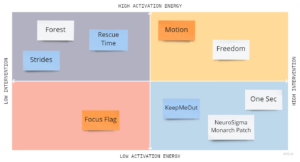
In our analysis, we found that the competitors were evenly distributed across the activation and intervention axes. Activation refers to the amount of energy required from the user to utilize the product whereas intervention is how effective the product is in terms of enhancing attention and productivity, either in the background or disruptively. From this definition and analysis, our aim is to develop OneTrack, a solution that requires low activation energy and has a high intervention.
Competitor Deep Dives

Rescue Time a cross-platform time-tracking app
This app will give you an accurate picture of how you spend your time. Some of their premium features include the ability to: block distracting sites during certain parts of the day, track offline activity (like meetings and phone calls), and log your daily accomplishments. You can also set alerts (ex: when you’ve spent more than two hours on Facebook) and goals (ex: spending less time in your inbox).
Strengths: Synchronized between web and desktop apps, this solution gamifies productivity and blocks distractions to help users work.
Weaknesses: This interface is difficult to understand and documentation is minimal. It also employs a freemium business model, with a high price point for critical features.

Freedom a cross-platform site-blocker and time-tracking app
Freedom reduces digital distraction across all of your devices. If the entire Internet is distracting you, you have the option to block the whole damn thing. You can start sessions one at a time, or plan your “distraction-free” time in advance. This helps you stay focused if you find yourself frequently distracted by social media and web browsing. Users of this app reportedly save an ~2.5 hours of productive time each day.
Strengths: At just $2/month users can block websites with ease across synchronized devices and schedule tasks for specific times.
Weaknesses: Another freemium business model, the free account allows only 7 sessions until all features are blocked behind a paywall.

Focus Flag a physical laptop gadget
This physical flag attaches to your laptop and flips up to let people know you’re focusing. It’s used in workplaces to prevent workplace distractions or around family or in public. This neat little invention is a simple physical tool that can be used to silently communicate with others that they’re in the zone and don’t want to be disturbed.
Strengths: The physical device minimizes distractions from people around you, and is a discreet non-screen signal.
Weaknesses: The device is not effective in tracking and intercepting distractions on the actual work devices. It has a narrow scope of solution.

KeepMeOut a web-based app timer and site-blocker
This easy-to-use web-based platform lets you regulate the websites you can use online by allowing you to block certain sites and set time limits and other regulations. It’s a simple solution that works in any browser that can be operated on a schedule or an ad-hoc basis.
Strengths: Users can easily generate unlimited bookmark links for distracting websites and pick time intervals for access. Without a registration or software installation, users will receive a warning before the site is blocked, and advanced settings even allow scheduling.
Weakness: This web service only works if you use the alias link that you were told to save as bookmark. In other words, you need to setup your bookmarks to use KeepMeOut to be blocked access to specific websites — you can still visit any website without restriction by typing and load the site’s direct link or URL on your web browser and not using KeepMeOut. Forgetting to use the alias bookmark and intentionally bypassing the restriction are easy in this system. There is also no mobile optimized version or privacy protection information.
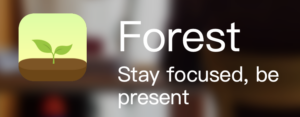
Forest a gamified sustainable productivity app
Forest is a productivity app that helps users stay focused on their tasks by gamifying the experience. Users plant a virtual tree in the app and the tree grows over time as long as the user stays focused and doesn’t leave the app. If the user leaves the app to check social media, for example, the tree dies. The app has a leaderboard so users can compete with friends to see who can stay focused the longest. Forest also has a feature where users can plant real trees with the coins they earn in the app.
Strengths: This easy-to-use app appeals to users who seek a simple and quick change. With great aesthetic appeal and trackable gamification progress, there’s a strong incentive for users to re-engage with app on their journey to sustainable and meaningful behavior change.
Weaknesses: This app is pretty simplistic and not as detailed or robust as an app with some users who are more serious about work. Additionally, users cannot export data or visualize their data for patterns, trends, or actionable insights.
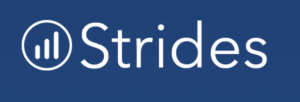
Strides a cross-platform goal-tracking app
Strides is a goal tracking app that helps users set and achieve their personal and professional goals. The app allows users to set goals in a variety of categories, including fitness, productivity, finance, and more. Users can track their progress towards each goal, set reminders and notifications, and view insights and reports to see how they’re doing over time. Strides also offers customizable goal templates, so users can quickly set up new goals, and a flexible goal-setting system that allows for simple or complex goal tracking. Additionally, the app integrates with Apple Health and other popular health and fitness apps, so users can seamlessly track their progress across multiple platforms.
Strengths: Strides allows users to track progress towards goals quantitatively and see robust visualizations. It’s personalized categories help create meaningful and actionable insights, and the app is integratabtle with other productivity apps.
Weaknesses: “Progress” is a loose term here, as measurements are not normalized. Additionally, setup of the platform requires a good deal of upfront time and energy. This app is also has critical paid features.

One Sec a cool-off mobile app for addictive distractions
This app adds a slight few-second delay before opening apps like Instagram, TikTok, etc. It forces you to think for an extra moment about why you want to go on that app. It can even make you fill out a poll to explain why before each time. Ultimately, it encourages users to slow down and evaluate their intentions for just a moment without actually preventing them from accessing what they’re trying to access or setting arbitrary screen time limitations. Finally, it can notify users every few minutes after they’ve been on an app to remind them to close it.
Strengths: This app leverages a cool-off period to foster delayed gratification when opening addictive apps and distractions. Users who want to be more conscious about their default behaviors can also see a report of their app usage to monitor your trends.
Weaknesses: Users can easily bypass the restrictions they’ve set for themselves and/or become frustrated with the wait times that the app imposes. Additionally, this solution only works for mobile apps.

Motion an automated and smart-schedule builder
Users input all of your tasks into this app and then it takes control of your calendar and uses AI to schedule them out for the next many days. It will rearrange your schedule if something takes longer than you anticipate and ensure everything gets done. It can handle task dependencies, tasks that take multiple time blocks over many days, and everything in between to help you build the ideal schedule and ensure you can productively get everything done.
Strengths: This app automates building a flexible schedule, so users who want to time-manage don’t have the overhead of actually time managing. The smart flexibility allows users to build schedules with task dependencies and contingency plans.
Weaknesses: The app still requires a bit of overhead, adding tasks and estimating the amount of time that will be taken. The cluttered interface could be overwhelming. It also sits behind a paywall.

Monarch Patch an overnight nervous-system regulator
This wearable was originally developed for children with ADHD. FDA-approved and scientifically backed, the Monarch Patch stimulates a facial nerve overnight that has been shown to help regulate behavior, attention, and emotion.
Strengths: This is one of the only medical-grade solutions we found, backed by rigorous research and testing. It fulfills the needs of users with severe attention regulation issues and works while they sleep, without any time/energy overhead during the day.
Weaknesses: This device is only offered for children with ADHD currently. It’s also a high-tech solution that is not easily accessible or re-creatable for consumer solutions.

Muse Headband a mindfulness wearable
For anyone who wants to meditate, this EEG device measures brain activity as you meditate. It translate “calm and settled” activity to peaceful weather sounds and “busy mind” activity to stormy weather sounds. It aims to help you bring your attention back to your breathing through this ambient and responsive cue.
Strengths: This wearable leverages neural activity during mindfulness/meditation sessions and is available to consumers who want active meditation sessions. Its interpretable cues during meditation sessions remind users to re-center their thoughts without distracting them. Supported by multitasking research, this mindfulness tool helps serve as a cue itself to help users set good habits.
Weaknesses: The strength of this solution does rely on creating the habit. Since this is a tricky process, users may not see benefits without sustained use. The product’s success is mostly demonstrated by user testimonials and not backed by medical research or scientific literature.
![]()
WatchMinder a mindfulness reminder wearable
Developed for children with ADHD/LD/Autism but used by anyone who wants to practice mindfulness throughout the day, this vibrating and programmable watch delivers discreet message notifications on a schedule.
Strength: Mindfulness habits are supported by scientific literature to improve the negative effects of and reduce multitasking. This product takes away the overhead of beginning a mindfulness habit on one’s own, and gives any consumer the ability to passively build mindfulness with this discreet wearable.
Weaknesses: Setting up the wearable does require some time investment, and results are mostly supported by user testimonials. The product is currently used by a majority children, so the wearable itself is not very aesthetic.
Conclusion
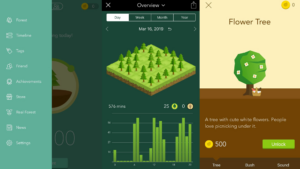
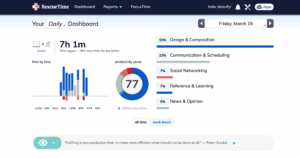
Other key insights that we got from this research include the appeal of a simple and easy to use UI that allows users of different experience levels to improve their productivity. We also saw the importance of gamification and incentives as a way to keep the users accountable and motivated to use our product. Additionally, a niche we we could explore is how to incorporate work/study breaks within the user’s time blocks as a way to reduce mental fatigue. Our key idea revolves around a cross-platform solution that would enable our users to sync their progress across multiple devices. We will combine these findings with those from our baseline studies as we explore ideas that can be implemented on the devices that the user uses to work.





Comments
Comments are closed.